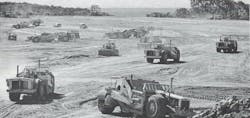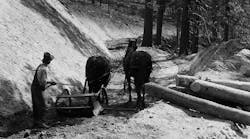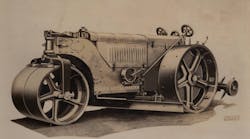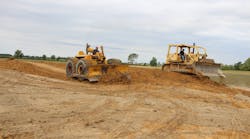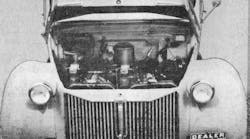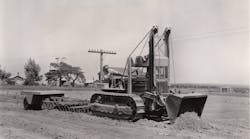Starting with this column, we’ll be going in a different direction. Instead of looking into the history of construction machines and their manufacturers, we’ll be exploring how these machines were used on noteworthy construction projects during the early and mid-20th century. Throughout those decades, many publications in the construction trade press ran detailed articles about major projects, and along with fostering interest in this history and the machinery that made it, this column is intended to be a tribute to those great stories and their authors.
We’ll start with one of the largest scraper projects on record, the excavation for the Ludington Pumped Storage Plant—on the shore of Lake Michigan, just south of Ludington, Mich.—in the late 1960s and early 1970s. The work involved removing 48 million cubic yards of sandy material to excavate for the power plant’s foundations and penstocks and to create a basin—2.5 miles long, a mile wide, and at its maximum, 110 feet deep—large enough to hold 27 billion gallons of water. The basin was then lined with an impervious layer of asphalt and clay.
The TS-24 motor scraper, first developed by the Euclid Division of General Motors in 1957 and continued by Terex until 1986, was an impressive machine. Its rated capacity was 40 tons, or 24 cubic yards struck and 32 heaped, and it was powered by two Detroit Diesel engines, one in the tractor and another on the scraper. As of early 1969, the engines totaled 605 flywheel horsepower, and the machine weighed 91,000 pounds empty.
Now imagine 81 of these big scrapers massed on a single project. Joint-venture excavation subcontractor Walsh-Canonie Companies selected this enormous fleet to do most of the digging and organized it into as many as 15 different spreads working simultaneously.
Each machine carried 22 cubic yards in place, compacted, adding up to 2,222 cubic yards per scraper, per day, working two 10-hour shifts. Assisted by nine single-engine S-24 scrapers of like capacity for utility work, production reached 180,000 cubic yards per day.
Project manager Jack DeSart said, “Our choice was based on capacity in relation to production schedules, terrain characteristics, various soil conditions, grades to be negotiated, and length of haul routes.” The hauls were up to 1,500 feet each way, with grades of up to 10 percent out of the basin.
Work started in the summer of 1968 and was completed in the fall of 1973 at a cost of $315 million. At the time, the Ludington Pumped Storage Plant was the largest facility of its kind in the world, and the project received the 1973 “Outstanding Civil Engineering Achievement” award from the American Society of Civil Engineers. An $800-million upgrade of the facility began in 2013 and is expected to be completed in six years.
(Original information from Terex Product Information S-19, April, 1971).
The Historical Construction Equipment Association (HCEA) is a 501(c)3 nonprofit organization dedicated to preserving the history of the construction, dredging, and surface mining equipment industries. With more than 4,000 members in 25 countries, its activities include publication of a quarterly educational magazine, Equipment Echoes; operation of the National Construction Equipment Museum and Archives in Bowling Green, Ohio; and hosting an annual working exhibition of restored construction equipment. Individual memberships are $35 within the United States and Canada, and US$45 elsewhere. We seek to develop relationships in the equipment manufacturing industry, and we offer a college scholarship for engineering and construction management students.
Information is available at www.hcea.net, 419.352.5616, or [email protected].
